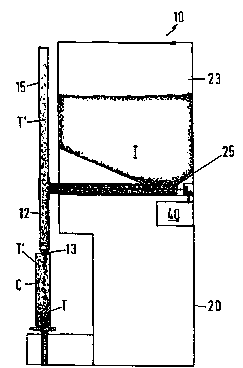Some of the information on this Web page has been provided by external sources. The Government of Canada is not responsible for the accuracy, reliability or currency of the information supplied by external sources. Users wishing to rely upon this information should consult directly with the source of the information. Content provided by external sources is not subject to official languages, privacy and accessibility requirements.
Any discrepancies in the text and image of the Claims and Abstract are due to differing posting times. Text of the Claims and Abstract are posted:
| (12) Patent Application: | (11) CA 2198220 |
|---|---|
| (54) English Title: | A MATERIAL DISPENSING APPARATUS |
| (54) French Title: | DISTRIBUTEUR DE MATERIAUX A FINES PARTICULES |
| Status: | Deemed Abandoned and Beyond the Period of Reinstatement - Pending Response to Notice of Disregarded Communication |
| (51) International Patent Classification (IPC): |
|
|---|---|
| (72) Inventors : |
|
| (73) Owners : |
|
| (71) Applicants : |
|
| (74) Agent: | MARKS & CLERK |
| (74) Associate agent: | |
| (45) Issued: | |
| (86) PCT Filing Date: | 1995-08-23 |
| (87) Open to Public Inspection: | 1996-02-29 |
| Examination requested: | 2000-02-23 |
| Availability of licence: | N/A |
| Dedicated to the Public: | N/A |
| (25) Language of filing: | English |
| Patent Cooperation Treaty (PCT): | Yes |
|---|---|
| (86) PCT Filing Number: | PCT/IE1995/000043 |
| (87) International Publication Number: | IE1995000043 |
| (85) National Entry: | 1997-02-21 |
| (30) Application Priority Data: | ||||||
|---|---|---|---|---|---|---|
|
An apparatus for dispensing fine particulate material comprises a hopper (23)
for storing material (T) to be dispensed, a discharge tube (12) having a
discharge nozzle (13) and feeding means comprising an auger (25) for
transferring stored material (T) from the hopper (23) to the discharge tube
(12). The fine particulate material is regulated by a metering means (35)
which meters the amount transferred by the auger (25) to the discharge tube
(12). Material (T) is transferred to a container (C) to be charged by
positioning it against the discharge nozzle so that the auger (25) transfers a
predetermined amount of material (T) from the hopper (23) to the discharge
tube (12). Material laden displaced air (T') from the container (C) escapes
into a settling tube (15) where the material in the displaced air (T') is
allowed to settle and fall by gravity into the container (C).
Un appareil distributeur de matière sous forme de fines particules comprend une trémie (23) pour le stockage de la matière (T) à distribuer, un tube d'évacuation (12) pourvu d'une buse d'éjection (13) et des moyens d'alimentation comprenant une vis (25) destinée au transfert de la matière stockée (T) de la trémie (23) au tube d'évacuation (12). La matière en particules fines est régulée par un moyen de dosage (35) qui dose la quantité transférée par la vis (25) dans le tube d'évacuation (12). La matière (T) est transférée dans un récipient (C) que l'on charge en plaçant celui-ci contre la buse d'évacuation de telle sorte que la vis (25) transfère une quantité prédéterminée de matière (T) de la trémie (23) au tube d'évacuation (12). L'air déplacé (T'), chargé de matière, qui provient du récipient (C) s'échappe dans un tube de dépôt (15) dans lequel la matière présente dans l'air déplacé (T') peut se déposer et tomber par gravité dans le récipient (C).
Note: Claims are shown in the official language in which they were submitted.
Note: Descriptions are shown in the official language in which they were submitted.

2024-08-01:As part of the Next Generation Patents (NGP) transition, the Canadian Patents Database (CPD) now contains a more detailed Event History, which replicates the Event Log of our new back-office solution.
Please note that "Inactive:" events refers to events no longer in use in our new back-office solution.
For a clearer understanding of the status of the application/patent presented on this page, the site Disclaimer , as well as the definitions for Patent , Event History , Maintenance Fee and Payment History should be consulted.
| Description | Date |
|---|---|
| Application Not Reinstated by Deadline | 2002-08-23 |
| Time Limit for Reversal Expired | 2002-08-23 |
| Inactive: Application prosecuted on TS as of Log entry date | 2002-01-31 |
| Inactive: Status info is complete as of Log entry date | 2002-01-31 |
| Deemed Abandoned - Failure to Respond to Maintenance Fee Notice | 2001-08-23 |
| Request for Examination Requirements Determined Compliant | 2000-02-23 |
| Amendment Received - Voluntary Amendment | 2000-02-23 |
| All Requirements for Examination Determined Compliant | 2000-02-23 |
| Application Published (Open to Public Inspection) | 1996-02-29 |
| Abandonment Date | Reason | Reinstatement Date |
|---|---|---|
| 2001-08-23 |
The last payment was received on 2000-08-21
Note : If the full payment has not been received on or before the date indicated, a further fee may be required which may be one of the following
Patent fees are adjusted on the 1st of January every year. The amounts above are the current amounts if received by December 31 of the current year.
Please refer to the CIPO
Patent Fees
web page to see all current fee amounts.
| Fee Type | Anniversary Year | Due Date | Paid Date |
|---|---|---|---|
| Registration of a document | 1997-02-21 | ||
| MF (application, 3rd anniv.) - standard | 03 | 1998-08-24 | 1998-08-21 |
| MF (application, 4th anniv.) - standard | 04 | 1999-08-23 | 1999-08-20 |
| Request for examination - standard | 2000-02-23 | ||
| MF (application, 5th anniv.) - standard | 05 | 2000-08-23 | 2000-08-21 |
Note: Records showing the ownership history in alphabetical order.
| Current Owners on Record |
|---|
| FAIRCOVE SYSTEMS |
| Past Owners on Record |
|---|
| WILLIAM RANKIN |